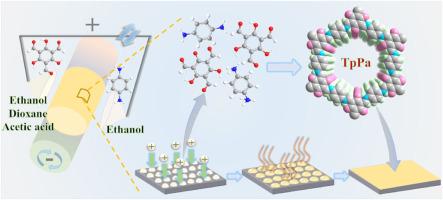Rapid preparation and mechanism investigation of covalent organic framework membranes by 3D printing based on electrostatic spraying
IF 8.4
1区 工程技术
Q1 ENGINEERING, CHEMICAL
引用次数: 0
Abstract
Covalent organic framework (COF) has great advantages in the field of membrane separation, but the efficient and convenient preparation of COF membranes is still a challenge. Herein, we propose a novel method with green solvent for the preparation of COF membranes based on electrostatic spraying, which can be successfully prepared within 10 min, forming the TpPa COF with a pore size of 1.8 nm. Molecular dynamics simulations demonstrate that electrostatic spraying enhances the reaction rate by lowering the energy barrier and increasing the movement of reacting monomers. Atomization of the solvent in electrostatic spraying causes the rapid volatilization of the solvent, resulting in supersaturation of the generated TpPa, precipitation and crystallization, and promotes the formation of TpPa COF structure. The optimal COF membrane for the separation of Congo red wastewater is prepared by adjusting the voltage, concentration, and spraying time, with selectivity of Na2SO4 for Congo Red attaining 118 and water permeance reaching 70.2 L m-2 h-1 bar-1. This work not only elaborates the membrane preparation mechanism in the electrostatic spraying process, but also greatly shortens the time of COF membrane preparation compared to the traditional method (2–3 days), which contributes to the possibility for practical application of COF membranes.

基于静电喷涂的 3D 打印共价有机框架膜的快速制备与机理研究
共价有机框架(COF)在膜分离领域具有很大的优势,但如何高效便捷地制备COF膜仍是一个难题。在此,我们提出了一种基于静电喷涂的绿色溶剂制备 COF 膜的新方法,可在 10 分钟内成功制备出孔径为 1.8 nm 的 TpPa COF。分子动力学模拟证明,静电喷涂可通过降低能障和增加反应单体的运动来提高反应速率。静电喷涂中溶剂的雾化会导致溶剂的快速挥发,从而使生成的 TpPa 过饱和、沉淀和结晶,并促进 TpPa COF 结构的形成。通过调节电压、浓度和喷淋时间,制备出了分离刚果红废水的最佳 COF 膜,Na2SO4 对刚果红的选择性达到 118,透水率达到 70.2 L m-2 h-1 bar-1。该研究不仅阐述了静电喷涂过程中的膜制备机理,而且与传统方法相比大大缩短了 COF 膜的制备时间(2-3 天),为 COF 膜的实际应用提供了可能。
本文章由计算机程序翻译,如有差异,请以英文原文为准。
求助全文
约1分钟内获得全文
求助全文
来源期刊

Journal of Membrane Science
工程技术-高分子科学
CiteScore
17.10
自引率
17.90%
发文量
1031
审稿时长
2.5 months
期刊介绍:
The Journal of Membrane Science is a publication that focuses on membrane systems and is aimed at academic and industrial chemists, chemical engineers, materials scientists, and membranologists. It publishes original research and reviews on various aspects of membrane transport, membrane formation/structure, fouling, module/process design, and processes/applications. The journal primarily focuses on the structure, function, and performance of non-biological membranes but also includes papers that relate to biological membranes. The Journal of Membrane Science publishes Full Text Papers, State-of-the-Art Reviews, Letters to the Editor, and Perspectives.
 求助内容:
求助内容: 应助结果提醒方式:
应助结果提醒方式:


